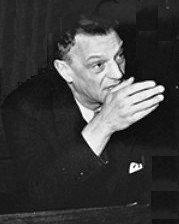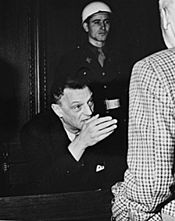Arthur Seyß-Inquart facts for kids
- The title of this article contains the character ß. Where it is unavailable or not wanted, the name may be written as Arthur Seyss-Inquart.
Quick facts for kids
Arthur Seyß-Inquart
|
|
|---|---|

Inquart at the Nuremberg Trials
|
|
| Chancellor of Austria | |
| In office 12 March 1938 – 13 March 1938 |
|
| Deputy Governor of Poland | |
| In office September 1939 – June 1940 |
|
| Reichkommissar of the Low Countries | |
| In office June 1940 – 8 May 1945 |
|
| Personal details | |
| Born | 22 July 1898 Stannern, Moravia |
| Died | Nuremberg, Germany 16 October 1946 |
| Political party | Austrian National Socialist Party |
| Spouse | Gertrude Maschka |
| Profession | Lawyer |
Arthur Seyß-Inquart (born Arthur Seyß on 22 July 1892 – 16 October 1946) was a lawyer who became a high-ranking Nazi official. He played a key role in Austria before it joined Nazi Germany, and later in Poland and the Netherlands during World War II. After the war, Seyß-Inquart was put on trial at the Nuremberg Trials for very serious crimes against humanity. He was found guilty and executed.
Contents
Early Life and Career
Arthur Seyß-Inquart was born in 1892 in a town called Stonařov, which was then part of the Austro-Hungarian Empire. His family moved to Vienna in 1907. There, they changed their Czech last name, Zajtich, to the German name Seyß-Inquart.
Arthur later studied law at the University of Vienna. When World War I started in 1914, he joined the Austrian Army. He fought in different countries like Russia and Italy. He was recognized for his bravery several times. While recovering from injuries in 1917, he finished his law degree.
In 1911, he met Gertrud Maschka. They got married in 1916 and had three children together.
After the war, Seyß-Inquart became a lawyer and opened his own law office in 1921. He became a successful lawyer and was asked to join the government in 1933.
Joining the Government
In 1937, Seyß-Inquart became a State Councillor. At first, he was not a member of the Austrian Nazi Party. However, by 1938, he became the most important Nazi politician in Austria.
In February 1938, Adolf Hitler threatened the Austrian leader, Kurt Schuschnigg. Because of this, Seyß-Inquart was made Minister of the Interior. On March 11, 1938, Schuschnigg resigned. Seyß-Inquart was then appointed Chancellor of Austria.
Hitler wanted Seyß-Inquart to ask Germany for help to stop made-up riots. However, the Austrian President did not make Seyß-Inquart chancellor until after Germany had already invaded Austria. On March 13, 1938, Seyß-Inquart officially joined the Nazi Party.
Role in Occupied Territories
After Germany invaded Austria, Hitler decided to make Austria a part of Germany. This event was called the Anschluss. Austria became a new German region known as Ostmark, meaning "eastern boundary." Seyß-Inquart helped write the law that made Austria a German province. He signed this law on March 13.
Seyß-Inquart became the Governor of Ostmark. He was also made an SS Gruppenführer, which was a high rank in the Nazi SS organization. In May 1939, he became a Minister in Hitler's government.
After Germany invaded Poland, Seyß-Inquart was made governor of Southern Poland. However, before he could start, a new area called the General Government was created. Seyß-Inquart then became a deputy to the Governor General, Hans Frank.
Governing the Netherlands
In May 1940, after Germany invaded the Netherlands, Seyß-Inquart became the Reichskommissar (meaning "Reich Commissioner") for the occupied Netherlands. His main tasks were to manage the country's government, connect its economy closely with Germany, and protect Germany's interests.
He supported the Dutch Nazi Party and allowed them to form a special police force. Other political parties were banned in 1941. Many former government officials were put in prison. Seyß-Inquart himself controlled much of the country's administration.
He introduced harsh rules to stop any resistance. When workers went on strike in May 1943, special courts were held. Many people were punished, and a large fine was placed on the cities. Seyß-Inquart allowed the execution of hundreds of people during his time in the Netherlands.
There were also two small concentration camps in the Netherlands. There was also a "Jewish assembly camp" at Westerbork. Many Dutch civilians were forced to work for the Germans, and many were sent to factories in Germany.
Seyß-Inquart was strongly anti-Jewish. Soon after he arrived, he removed Jewish people from government jobs, the press, and important industry positions. Anti-Jewish actions increased after 1941. About 140,000 Jewish people were registered. A special area for Jewish people was created in Amsterdam, and the transit camp at Westerbork was set up.
In February 1941, 600 Jewish people were sent to the Buchenwald and Mauthausen concentration camps. Later, many Dutch Jewish people were sent to Auschwitz. As Allied forces got closer in September 1944, the remaining Jewish people at Westerbork were sent to Theresienstadt. Out of 140,000 registered Dutch Jewish people, only 44,500 survived the war.
When Hitler died on April 30, 1945, Seyß-Inquart became the Foreign Minister in the new German government led by Admiral Karl Dönitz.
The Nazi government had a plan to destroy everything valuable to prevent it from falling into Allied hands. This was called a 'scorched earth' policy. However, Seyß-Inquart agreed with another minister, Albert Speer, that destroying everything was wrong. Seyß-Inquart also helped distribute food during the severe 'hunger winter' of 1945. He allowed Allied planes to drop food for the hungry people in the northern Netherlands. He remained Reichskommissar until May 8, 1945. He was captured in Hamburg after confirming that he had stopped the 'scorched earth' orders.
Nuremberg Trials
At the Nuremberg Trials, Seyß-Inquart faced charges for his actions during the war. These included planning aggressive wars, war crimes, and crimes against humanity.
His lawyer was Gustav Steinbauer. However, Seyß-Inquart was found guilty of all charges except one. He was hanged on October 16, 1946, when he was 54 years old. Nine other people were also executed with him. His last words were about hoping for peace and understanding between people after the war.
| Preceded by Kurt Schuschnigg |
Chancellor of Austria 1938 |
Succeeded by Adolf Hitler as Fuhrer of Germany - Post Abolished |
| Preceded by Joachim von Ribbentrop |
Foreign Minister of Germany 30 April 1945 |
Succeeded by Count Lutz Schwerin von Krosigk |
Images for kids
-
Seyss-Inquart in The Hague (1940)
See also
 In Spanish: Arthur Seyß-Inquart para niños
In Spanish: Arthur Seyß-Inquart para niños





